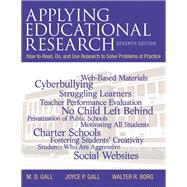This title is only available as a loose-leaf version with Pearson eText.
Applying Educational Research focuses on relating research to practice, helping educators see the relevance of research to their daily work. This goal of making research relevant is accomplished by focusing on current “problems of practice.” Each chapter highlights a set of important issues for teachers, students, and schools–-issues like teacher evaluation, the effectiveness of close-reading strategies, and the use of computer-supported instruction. The research examples and articles in the chapter then address these issues, providing students a meaningful context for the information they are learning about research methods. Through this approach, students learn about the research process and current research on topics that directly impact practice.
From reviews of the text:
The writing style of the textbook is excellent . . . . Writing clarity for content builds from one paragraph to another. . . . The Gall, Gall, and Borg textbook is the only text I would consider for [my Master’s-level research course]. Because the authors are scholars and practitioners, they bring a depth and range to the topic of educational research that is unsurpassed."
--Vikki K. Collins, Troy University
"The writing style is very clear. I find it easy to read and navigate among the chapters. Most graduate students in my class will not have any problems reading the book. The authors provide a very gentle introduction to educational research. . . . The authors adopt a balanced view of educational research. . . . They have explained most of the quantitative analyses used in educational research, and they have explicated the major theories of qualitative research. They have introduced the research techniques in a clear manner accessible to a broad audience inside and outside of the education field."
--Xiaofeng Steven Lui, University of South Carolina
0133831574 / 9780133831573 Applying Educational Research: How to Read, Do, and Use Research to Solve Problems of Practice, Loose-Leaf Version with Video-Enhanced Pearson eText -- Access Card Package
Package consists of:
0132868636 / 9780132868631 Applying Educational Research: How To Read, Do, and Use Research To Solve Problems of Practice, Loose-Leaf Version
0133398811 / 9780133398816 Applying Educational Research: How To Read, Do, and Use Research To Solve Problems of Practice, Pearson eText -- Access Card








